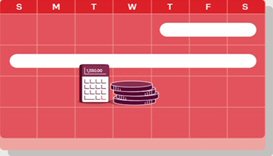In order for us to get to the new pay cycle, we must go through a fortnight of transition. This is inevitable and a transition pay is industry best practice and it is the only way to move from one pay cycle cadence to another.
The transition pay fortnight will consist of:
17 days of Entitlement Pay (consisting of the 10 days from the previous fortnight, and bringing forward 7 days of Entitlement Pay into the new cycle).
Transition Pay Cycle

While the transition pay does consist of 3 days less ordinary pay, employees will still be getting paid for every day they work, and they will also receive 7 additional days of Entitlement Pay which will be brought forward. If this is not enough for an employee to cover their usual expenses, we have already taken you though the $300 transition assistance payment (tax-free) which is repaid over the following subsequent 3 pay period at $100 a pay.
We do however expect many employees to be in a better financial position in the transition pay period given the extra overtime, shift penalties, etc. that they will receive. For example, we have run a scenario based on employee's current roster:
Role: Full-Time PDO
Current Pay
Normal Salary 73:30 (10 days) $1,927.71
Entitlements (10 days) $1,049.49
TOTAL $2,977.20
Transition Pay
Normal Salary 51.45 (07 days) $1,349.39
Entitlements (10 days) $1,049.49
Entitlements (7 days) $ 734.44
TOTAL $3,133.62
DIFFERENCE +$ 156.42
We appreciate that not all employees will have worked a lot of overtime, or in the rare cases, have shift penalties, however this is precisely why we have set up the transition assistance payment so that employees who are concerned that their transition pay may not meet their current financial liabilities can have that extra support. If you believe that the current transition assistance arrangements do not meet these employees' needs, I would be more than happy to discuss any other alternatives that you or your stakeholders would like us to consider.
Our feedback from employees in focus groups and through our initial training sessions on the pay cycle realignment and the transition pay has been overwhelmingly positive. Employees are excited about getting all of their pay in one instalment, and have shown a good reception to the transition assistance if they need it, with all accepting the fairness of the repayment of the $300 transition assistance. However, as we discussed in our various meetings, one size does not fit all, and we will be open and accepting of those who need additional assistance during this time.
Greg's Questions
While I hope the above has answered your questions, I have also provided more targeted answers below:
1. Are three days' pay being withheld to be paid on the employee's retirement/resignation?
No - employees will receive payment for the days that they have worked. The transition pay is a shorter pay period of seven instead of ten workdays, with the remaining 3 days falling into the following pay period. The good news story here is that the 10 days of Entitlements Pay that is usually held back a fortnight will now be paid at the same time as ordinary pay, which provides employees an additional 7 days of entitlement pay in the transition pay.
2. Will employees be paid for everyday worked for the pre and post transition period on the next scheduled pay day?
Yes. As stated above, no employee will be short-paid. They will be paid everything they are entitled to in the next scheduled pay.
3. Will employee's be paid for each day worked during the transition period on the next scheduled pay day?
Yes. Australia Post will pay what they have worked and are entitled to.
4. Is there any day where employees will not be paid?
No. Australia Post will pay what they have worked and are entitled to, however 3 days from one pay cycle will fall into the following pay cycle.
I hope this provides some clarity about these arrangements, however if you would still like to discuss these matters further, please contact me or Tom Dixon, Senior ER Partner.
Yours sincerely, Project Delivery Manager
Authorised by Dan Dwyer NSW Secretary, Sue Riley Vic Secretary
- CWU Telecommunications & Services Branches.

